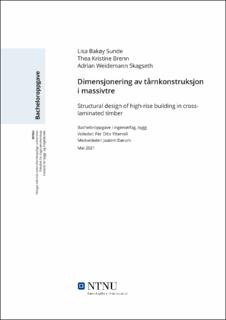| dc.contributor.advisor | Yttervoll, Per Otto | |
| dc.contributor.advisor | Dørum, Joakim | |
| dc.contributor.author | Sunde, Lisa Bakøy | |
| dc.contributor.author | Brenn, Thea Kristine | |
| dc.contributor.author | Skagseth, Adrian Weidemann | |
| dc.date.accessioned | 2021-09-20T16:32:49Z | |
| dc.date.available | 2021-09-20T16:32:49Z | |
| dc.date.issued | 2021 | |
| dc.identifier | no.ntnu:inspera:81154281:81155200 | |
| dc.identifier.uri | https://hdl.handle.net/11250/2779544 | |
| dc.description.abstract | I en bransje som står for et høyt utslipp av CO2 er det viktig å finne løsninger for å minske miljøavtrykket. Trevirke har vært et basismateriale i byggebransjen i lang tid, men i dag består bæresystemet i større konstruksjoner i hovedsak av betong- og stålelementer. I denne oppgaven vil det bli undersøkt hvor høyt en konstruksjon kan dimensjoneres, bestående av hovedsakelig massivtre. Å benytte massivtreelementer i konstruksjoner vil ikke bare være gunstig for miljøet, men vil også gi en effektiv montasje.
Konstruksjonen som prosjekteres i denne oppgaven er et pentagonformet tårn i massivtre. Hver etasje består av 5 stykk 3,5 x 16m plater fra Splitkon som utgjør en etasjehøyde på 16 meter. Problemstillingen i denne oppgaven omhandler hvor høyt tårnet kan bygges for det gitte lastbildet, uten bruk av stål- og betongforsterkninger. Konstruksjonen avsluttes med en toppetasje på 3 meter.
For å finne endelig høyde ble konstruksjonen modellert i Focus Konstruksjon og kontrollert for hver høyde med beregnede lastpåkjenninger. Det vil i høye trekonstruksjoner oppstå store krefter fra ulike lastpåkjenninger og da spesielt store vindkrefter. For massivtre som er et relativt lett materiale, vil det oppstå problemer med å kunne stabilisere konstruksjonen mot store horisontale krefter. Dette skaper stor forskyvning i toppen av tårnet som vil bli avgjørende i forhold til krav i bruksgrensetilstand, satt etter menneskers komfort.
Lineær lastanalyse i Focus Konstruksjon ga resultater som avgjorde hvor høyt konstruksjonen kunne dimensjoneres, med gitt lastbilde. Etter utførte beregninger og analyser landet resultatet på et 51 meter høyt tårn, hvor begrensningen ble bruksgrensekravet for forskyvning.
Den maksimale tårnhøyden dannet grunnlaget for videre dimensjonering og kontroller for de ulike konstruksjonselementene. Kapasitetskontrollene ble utført etter Norsk Standard, som setter prosjekteringskrav til konstruksjoner av ulike materialer. Den svenske massivtrehåndboken, utviklet av Swedish Wood ble også benyttet.
Sammenføyningene i konstruksjonen ble dimensjonert med ulike forbindelser fra Rothoblaas og SFS intec. Dette ble utført etter leverandørens egne tekniske datablader og ETA, i tillegg til Norsk Standard. | |
| dc.description.abstract | In an industry that accounts for high CO2 emissions, it is crucial to identify and implement solutions that reduce the environmental footprint of its actions. Timber has been an essential material for a long time, however today the load-bearing system in larger structures mainly consists of concrete and steel. This thesis will investigate how high a construction can be designed, using primarily CLT, cross-laminated timber. Using CLT in constructions will not only be beneficial for the environment, but also timesaving.
The construction projected in this thesis is a pentagon shaped tower in CLT. Each floor consists of 5 pieces of 3,5 x 16m plates from Splitkon which make up a floor height of 16 meters. Achieving the highest rise of the tower without any reinforcement from steel and concrete is the challenge in this thesis. The construction ends with a 3-meter-high top floor.
To find the highest possible rise of the tower, Focus Construction was used to create a model that was controlled for each height with specific load stresses. Large forces will arise in tall timber buildings from various load stresses and especially from wind forces. For CLT, which is a relatively light material, issues concerning stability from horizontal stresses will arise. This creates displacement in the top floor which will be crucial in relation to requirements in the service limit state, set according to human demands.
Linear load analysis in Focus Construction resulted in how high the construction could be designed, with the specific load stresses. After calculations and analyzes the result ended with a 51-meter-high tower limited by the service limit state requirements for displacement.
The maximal tower height formed the basis for further capacity calculations and controls for the various construction elements. The capacity checks are performed in accordance with Norwegian Specification, which sets the design conditions for the assorted construction elements. The Swedish CLT Handbook, made by Swedish Wood, has also been used.
Connections in the building was designed with various joint solutions from producers Rothoblaas and SFS intec. This was carried out according to the producers own technical data sheets and ETA, in addition to Norwegian Specification. | |
| dc.language | nob | |
| dc.publisher | NTNU | |
| dc.title | Dimensjonering av tårnkonstruksjon i massivtre | |
| dc.type | Bachelor thesis | |
